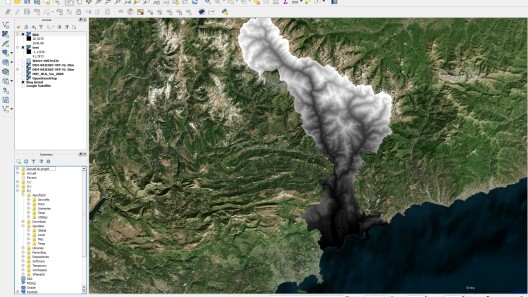Hello,
I'm trying to build a mesh for the area of Nice, France with a DEM of 5 meters resolution from the open data portal of the Municipality.
Here is the DEM converted to TIFF in QGIS:

Here are its coordinates in its original CRS:

And here they are in the standard CRS (EPSG:4326):

My TFW file:
0.0000654927
0
0
-0.0000426
6.743398875698556
44.36568831142908
My TMC file:
<[file][][]
<[tmcolormap_regions][][]
<[string] [folder_source_files][./input/elevation-nice/]>
<[bool] [write_images_with_mask][false]> // global flag -> if this is true, no image is created
// if a mask is required. if this is false you can still
// disable mask images for a selected level, see below
// images with mask are always 'problematic'. rule of thum
// is to create an area as large as possible
<[bool] [write_ttc_files][false]>
<[bool] [do_heightmaps][true]>
<[string8][folder_destination_ttc][./output/images/]>
<[string8][folder_destination_heightmaps][./output/elevation/]>
<[bool] [always_overwrite][true]>
<[list][region_list][]
<[tmheightmap_region][element][7]
<[uint32] [level] [7]>
<[vector2_float64] [lonlat_min] [6.743398875698556 43.63047716301322]>
<[vector2_float64] [lonlat_max] [7.467846368136574 44.36568831142908]>
<[bool] [write_images_with_mask][false]> // do not create images that would require a mask
>
<[tmheightmap_region][element][8]
<[uint32] [level] [8]>
<[vector2_float64] [lonlat_min] [6.743398875698556 43.63047716301322]>
<[vector2_float64] [lonlat_max] [7.467846368136574 44.36568831142908]>
<[bool] [write_images_with_mask][false]> // do not create images that would require a mask
>
<[tmheightmap_region][element][9]
<[uint32] [level] [9]>
<[vector2_float64] [lonlat_min] [6.743398875698556 43.63047716301322]>
<[vector2_float64] [lonlat_max] [7.467846368136574 44.36568831142908]>
<[bool] [write_images_with_mask][false]> // do not create images that would require a mask
>
<[tmheightmap_region][element][10]
<[uint32] [level] [10]>
<[vector2_float64] [lonlat_min] [6.743398875698556 43.63047716301322]>
<[vector2_float64] [lonlat_max] [7.467846368136574 44.36568831142908]>
<[bool] [write_images_with_mask][false]> // do not create images that would require a mask
>
<[tmheightmap_region][element][11]
<[uint32] [level] [11]>
<[vector2_float64] [lonlat_min] [6.743398875698556 43.63047716301322]>
<[vector2_float64] [lonlat_max] [7.467846368136574 44.36568831142908]>
<[bool] [write_images_with_mask][false]> // do not create images that would require a mask
>
<[tmheightmap_region][element][12]
<[uint32] [level] [12]>
<[vector2_float64] [lonlat_min] [6.743398875698556 43.63047716301322]>
<[vector2_float64] [lonlat_max] [7.467846368136574 44.36568831142908]>
<[bool] [write_images_with_mask][false]> // do not create images that would require a mask
>
>
>
>
Display More
But the result is not perfect as you can see 

The issue is not only about the heights, the impacted surface is not really correct too...
Any idea of what's could be wrong in my settings ?
Note that I have to close manually the Geoconvert window at the end of the process (100% of the tiles are generated) but this can be considered as "normal" as said in another topic.
I'd would rather see an error with the pixel size (line 1 and 4 in the TFW file).
Thanks for your help, Vincent.
